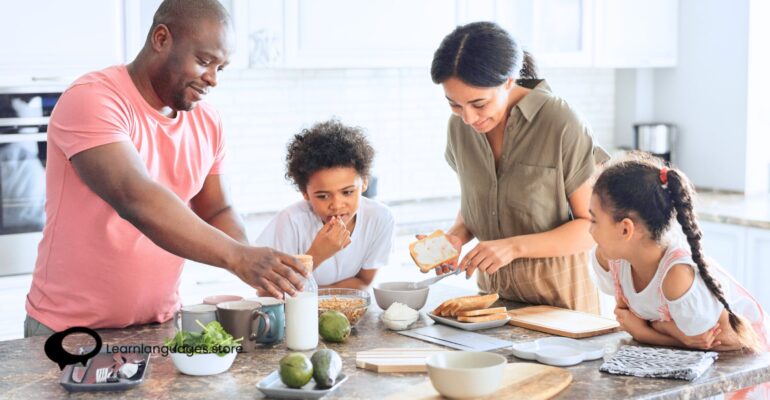HOW TO USE YOUR LOVE OF COOKING AND FOOD TO LEARN A NEW LANGUAGE
HOW TO USE YOUR LOVE OF COOKING AND FOOD TO LEARN A NEW LANGUAGE
Learn a new language, try new foods, and learn about other cultures all at once!
Estimated reading time: 7 minutes
I teach foreign languages. One of the things that my students ask me most often is how to learn a new language and become fluent in it and cooking.
Well, a good language school can help. It’s also great to make a good language training programme that you can do at home.

But the real key to learning a new language is to use what you’re interested in. From what I’ve seen, the kids who did best turned something they liked into a way to learn a language. Using the things you enjoy to learn a language is a good way to keep at it for a long time.
And if food is important to you, you’re in luck.
es have a unique chance to use their passion to learn a new language because there is no better way to learn about a country than through its food (or maybe its music).
Food can teach you a lot. Recipes are a great way to learn new and useful words, especially for food, home items, and verbs used in the kitchen. You might learn some new cooking skills while you’re learning a new language. And to top it all off, you’ll get a delicious meal when your “studying” is don and cooking.
So, without further ado, here’s how to get started with

How to Use Food and Cooking to Learn a Language
Take a language class to start.
If you are just starting to learn a language, you might not be ready to start reading recipes right away. It’s smart to start with the basics.
Taking a language class can be a great way to get started. Even if you’ve been learning a bit on your own, taking a class in the language you want to learn will help you make sure you know the basics of grammar, how to conjugate verbs, have some basic vocabulary, and so on.
It focuses on real conversational practise, real listening drills, and so on.
It’s also interesting and fun, so you’ll like adding it to your study schedule.
So start there. Take a language school to learn at least the basics of the language you want to learn.
Read recipes in the language you want to learn.
Step two is to start reading recipes in the language you want to learn. Recipes are great to read because they are often short and written in clear, simple language.
Here are some ways to use recipes to improve your speaking skills.

Learn the terms that are most often used in the kitchen. Before diving into blogs, videos, and cookbooks in the language you’re learning, it’s a good idea to quickly study some of the most common culinary verbs so you don’t feel lost or upset when you’re first starting out. Before you start reading recipes, it will be helpful to know verbs like mix, wash, peel, boil, bake, chop, slice, season, cook, and grate.
Find out about words you don’t know. As soon as you start reading recipes, you’ll run into new words. Even when you’re at an intermediate level, you’ll still find new words all the time. If you don’t know what a word means, you should look it up. Then try to think of it in terms of the recipe. For example, if you want to learn the word “boil,” picture a pot of hot water boiling on the stove. Researchers have found that using memory tricks like putting words with pictures helps people learn better.
Use a vocabulary notebook to write down the new words. A vocabulary notebook is a great way to remember new words and phrases. It is really just a place to write down the new things you learn, like a personal dictionary. You can easily keep track of words with apps like Quizlet, Google Keep, Brainscape, Anki, and Evernote. You can also make your own language app, or you can just use a paper notebook. I would like you to add more facts, synonyms, antonyms, and examples to your vocabulary journal.
Netflix has cooking shows you can watch.
Netflix gives people who want to learn a language a lot of options. For example, watching a TV show or movie is great because it gives you a visual background for the language, which makes it easier to understand what’s going on.
If you like food, there are a lot of shows on Netflix about food and cooking.
You can change the language on Netflix to hear these shows in the language you want to learn. Or, try this Google app that lets you watch Netflix in a number of different languages and includes a dictionary and translations.

Bring food to a language gathering.
Food is meant to be shared; it brings people together. So why not share your new work with other people who want to learn the language?
This is a great use for Meetup. It lets you find other people in your city who are also learning a language. You can get together to talk and talk about how hard it is to speak more than one language. If you bring a tasty treat to share, you’ll make friends quickly.
Can’t meet up in person? No problem! There are several apps that let you meet other online language learners. Some options include:
HelloTalk is available in two languages:
Check out our tips on how to have virtual talks, practise your language online, and make your online language exchange work.
Ask your new friends what kind of food they like and if they have any good recipes. And be ready to talk about yours!
What Should You Cook?
So you agree that food could be the key to quickly learning a new language? What should you cook, though?
If you don’t like to try new things with your food, look for meals that remind you of foods you already know you like. This is a good plan even if you don’t think you’re a very good cook.
If you are a little more bold and love to try new things, the sky’s the limit. Find foods that are typical of the people who speak the language you want to learn.
Here’s some ideas from our blog to get you started:
South America Try making cocktails and poblanos from Mexico.
Check out these foods from the Spanish peasant class.
Learn about the five things that make up Japanese food.
Try one of these French soup recipes for winter.
There are, of course, lots of other ideas on the Internet, such as:
Brazilian Portuguese: Brazilian feijoada
Italian: Pizza Margherita
German: Sauerbraten mit Rotkohl und Kartoffelkloßen
Do you know of any other great sites with recipes and food tips in another language? You can share them in the comments.
Learn Languages Store
Vashi,
Email: services@learnlanguages.store










